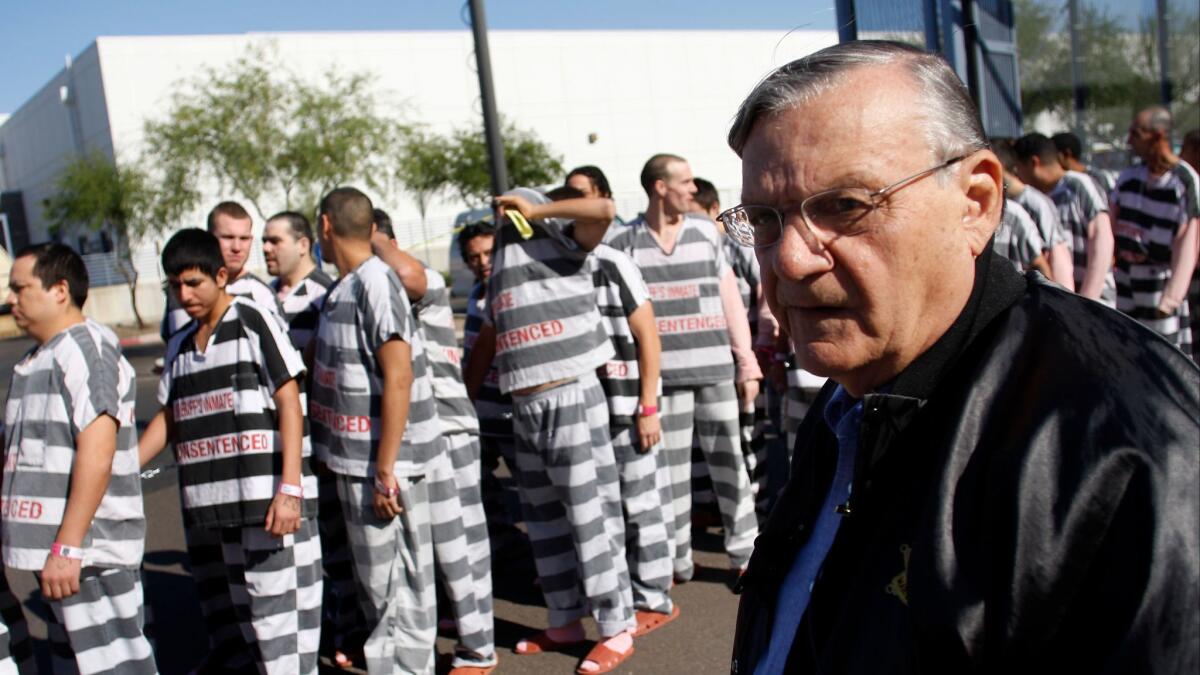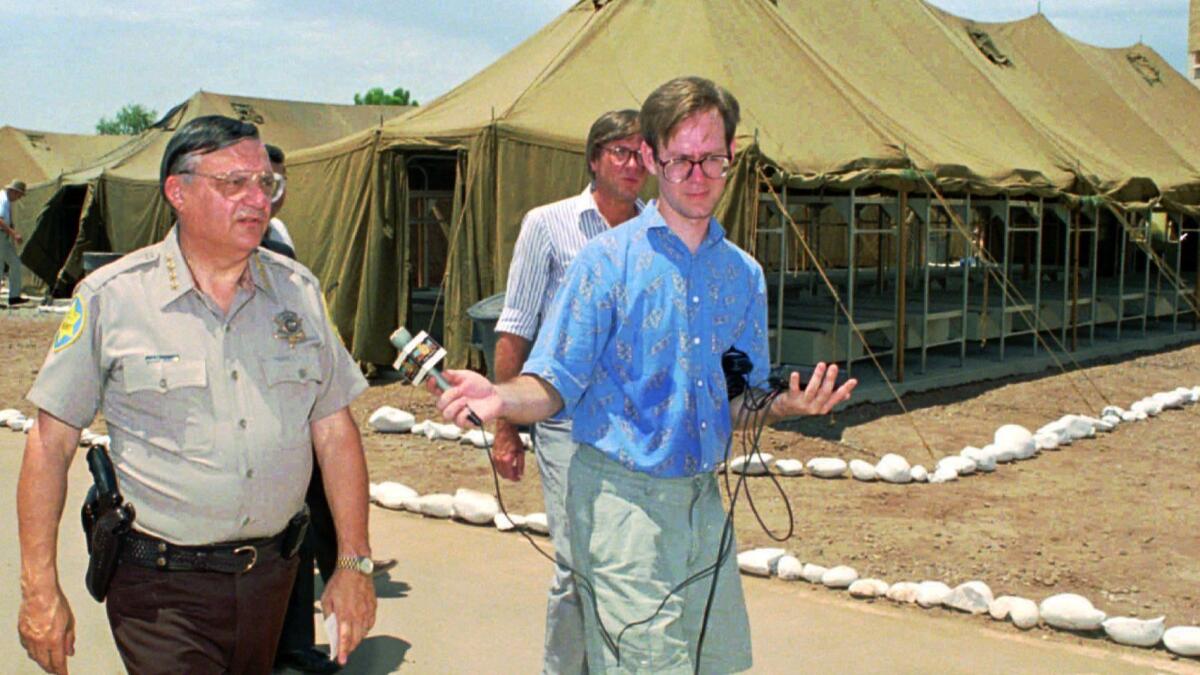Timeline: The rise and fall of Arizona Sheriff Joe Arpaio

- Share via
On Monday, one of the nation’s most famous lawmen, former Maricopa County, Ariz., Sheriff Joe Arpaio, became a criminal. The 85-year-old was found guilty of criminal contempt of court for ignoring a federal judge’s order forbidding his department from targeting Latinos. Here’s a look at Arpaio’s long and controversial career in law enforcement.
June 14, 1932: Joseph M. Arpaio, the son of Italian immigrants, is born; his mother dies during childbirth. (“They came through Ellis Island legally,” Arpaio later told New Yorker magazine.) He grows up in Springfield, Mass., where his father runs a grocery store.
1950: Arpaio enlists in the Army after he turns 18 but doesn’t see combat in the Korean War. He serves in the Medical Detachment Division, “where report writing skills and interviewing techniques were critical,” he later wrote.
1954: Arpaio becomes a police officer in Washington, D.C., where he serves three years as a beat cop. He then serves a short stint in the sheriff’s department in Clark County, Nev., where he claims to have stopped Elvis Presley for a traffic citation.
1957: Arpaio joins the U.S. Bureau of Narcotics, the precursor to the Drug Enforcement Administration. “The bureau was in need of Italian Americans willing to work undercover and arrest fellow Italians,” Arpaio later wrote on a campaign website, adding, “I was up to the task.” Arpaio worked around the world in locales including Turkey, Lebanon, South America and Mexico.
1982: After a career spanning more than two decades, Arpaio retires from the DEA as the agency’s top official in Arizona. He and his wife, Ava, open a travel agency in Phoenix.
1992: Arpaio runs for Maricopa County sheriff and defeats incumbent Tom Agnos, whose department was under fire for extracting false confessions in the massacre of six Buddhist monks, two young initiates and an elderly nun in 1991. Arpaio promises to serve only one term.
1994: Arpaio starts winning the national limelight for his brash techniques. He mobilizes a 2,200-member volunteer posse, which includes lawyers, doctors, politicians, corporate executives and retirees, to patrol for prostitutes and mall crime. He bans coffee and movies in the county jail and erects a tent city for inmates surrounded by concertina-wire fence. “I’ve got a method to my madness of publicity: I want to send a message to the bad guys,” Arpaio tells the Los Angeles Times in a front-page story. “I want them to know that it is so bad in my jail that they won’t want to commit crimes here.”

1995: Arpaio forces inmates to wear pink underpants and reintroduces chain gangs. The U.S. Justice Department starts investigating jail conditions under Arpaio’s watch.
1996: Polls show Arpaio, who is running for the first of his many reelections, is the most popular politician in the state. He starts winning the attention of national Republicans, including presidential candidate Bob Dole, who visits the tent city and praises it. “This idea may spread in other sections of the country,” Dole says. “I talked to one of the inmates who said, ‘I don’t want to come back here. I’ve learned my lesson.’” Two months later, hundreds of inmates riot in protest of conditions at the camp.
1997: The Justice Department sues Maricopa County, alleging the use of excessive force and mistreatment at the jail, but the suit is dropped.
1999: Maricopa County settles a wrongful-death lawsuit by paying $8.25 million to the family of an inmate who died after a struggle with guards in 1996.
2000: Arpaio launches a “jail cam” website showing livestreams of inmates from inside the jail. The site receives 3 million visitors and crashes on the first day.
2001: Following complaints, Arpaio turns off one of the jail cameras that showed female inmates using the toilet, which had been picked up by porn websites.
2002: Despite favorable polls, Arpaio decides not to run for governor of Arizona, saying, “I just want to go out into the sunset as a law enforcement officer.”
2004: A court rules that Arpaio’s jail cameras violate the rights of pre-trial detainees, who have not been convicted of crimes.
2006: With help from his posse of citizens, Arpaio uses a state human-trafficking law to start going after smugglers bringing immigrants into Arizona illegally — and also to arrest the immigrants. “Let them go to California,” Arpaio said.
2007: A Mexican citizen visiting the U.S. legally sues Arpaio after he is detained. The litigation would eventually become a class-action lawsuit, one of several legal actions to be taken against Arpaio in the coming years.
2008: Following a lawsuit by the American Civil Liberties Union, a federal judge rules that conditions in Arpaio’s jail are unconstitutional.
2010: The Justice Department sues Arpaio, saying his department was refusing to cooperate with an investigation of whether it discriminated against Latinos while trying to catch illegal immigrants. Reports note that some of Arpaio’s deputies and volunteers stop people for minor infractions and then ask them for their citizenship status. Federal officials say Arpaio was the first local law enforcement official in 30 years to refuse to provide documents in a federal civil rights inquiry. Arpaio turns over the information after a settlement a year later.
2011: A federal judge orders Arpaio and his deputies not to racially profile Latinos.
2012: The Justice Department sues Arpaio again, alleging a pattern of illegal discrimination against Latinos. Arpaio wins reelection by only a few percentage points. Also, Arpaio announces that volunteer investigators working for him have concluded that President Obama’s birth certificate is not legitimate.
2013: In response to a class-action lawsuit filed by the ACLU, a federal judge rules that Arpaio’s deputies illegally profiled Latinos.
2015: The Justice Department and Arpaio partially settle some of the claims in the 2012 lawsuit.
2016: Arpaio endorses Donald Trump for president, and Trump responds that he has “great respect” for the sheriff. A federal judge finds Arpaio and some of his top deputies in civil contempt of court on suspicion of continuing to target Latinos, and federal prosecutors charge Arpaio with criminal contempt of court. Arpaio loses his bid for reelection after six terms in office to former Phoenix Police Sgt. Paul Penzone.
2017: In a criminal bench trial, Arpaio is found guilty of defying a federal judge’s order to stop racially profiling Latinos. He plans to appeal, saying he was wrongfully denied a trial by jury, which he believes would have found him innocent. He faces up to six months in jail. His sentencing is later this year.
More to Read
Sign up for Essential California
The most important California stories and recommendations in your inbox every morning.
You may occasionally receive promotional content from the Los Angeles Times.











